
What you need:
- You and a toddler!
Directions:
- Imitation is the ability to watch what someone else is doing and copy them. It is an important aspect of social interaction: babies learn by imitating their caregiver. Toddlers learn the joy of engaging, and being together! They imitate expressions, gestures, play and life skills, vocalization and sounds.
- This repetition game promotes balance and flexibility, listening and observation skills (focus and fun!) and introduces the letters of the alphabet through creative movement. It is a great brain-body booster. Act out your favorite animal poses, A to Z. Try a new one each week!

A is for Alligator, move your body with me! [Chomp, chomp chomp! x2]
B is for bat! [Flap, flap, flap! X2 in a circle]
C is for chicken who goes [cluck, cluck, cluck! (fold arms and tuck under) x2]
D is for dog who chases his tail! Who chases his tail!
E is for elephant who stretches out his trunk! Who stretches out his trunk!
F is for flamingo who balances on one leg! Who balances on one leg!
G is for giraffe who stretches up real tall! Who stretches up real tall! (on tip-toe)
H is for honeybee who buzzes all around! Who buzzes all around!
I is for Iguana who moves reeal sloow, Who moves reaal sloow.
J is for Jaguar who leaps real quick! Who leaps real quick!
K is for kangaroo [who hops up and down! x2]
L is for lion who [roars! (Move your head around in a circle x3)]
M is for mouse who [squeaks, squeaks, squeaks! (tiny voice) x2]
N is for Narwal tusk who [swims, swims, swims! X2]
O is for Oyster who curls up in a ball! curls up in a ball!
P is for penguin who waddles very tall! Who waddles very tall!
Q is for quail [flit, flit flit (dart to and fro) x2]
R is for rabbit [hop, hop, hop x2]
S is for slug who leaves a shiny trail! Who leaves a shiny trail!
T is for tortoise, bigggg and rounnnd, bigggg and rounnnd.
U is for sea urchin who dances on the bottom! Who dances on the bottom! (sit on your bottom, tap your feet and slowly rotate around in a circle)
V is for viper who slithers like a snake! Slithers like a snake!
W is for wolf who howls! (long, slow howl pointing head up at the moon)
X is for x-ray zebra fish who [darts, darts darts! x2]
Y is yellow ground squirrel who [pops up and down! X2]
Z is for zebra who gallops all around! Gallops all around!
Ways to expand the activity:
- Regular imitation opportunities like finger play songs, hand puppets, or games like follow the leader and Simone Says reinforce play skills, peer play and engaging with others.
What do they learn?
- Social emotional connection. The imitation of facial expressions and vocalizations like cooing and smiling facilitate bonding and can express social interest rather than a physical need.
- Sharing knowledge and learning new concepts: blowing a kiss (I love you), waving (hello or goodbye), expressing size (so big, or so small), rubbing a tummy (hungry or full) or banging on a drum (I can make music!).
- Language and taking turns. Back and forth imitation is early conversation without words.
